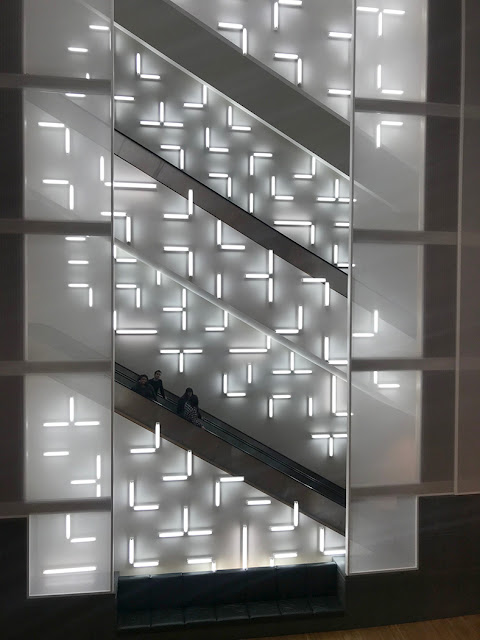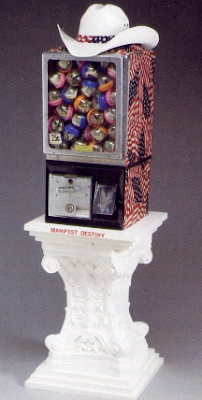Last week we traveled to the the Indianapolis Art Museum/Newfields and the Eiteljorg Museum of American Indians and Western Art. At the IMA, the goal was to see some of the artists we would study this semester (James Turrell) or view on the road trip (Robert Irwin). The City as Canvas, a NYC graffiti filled extravaganza was also on display and we immersed ourselves in 1980s rap music, pay phones, and recreations of subway system signage.
Celina, Alex, Kaiti and Alix in front of Robert Irwin's Light and Space III at the Indianapolis Museum of Art / Newfields
The light falling on the doorway walking out of James Turrell's Acton at the Indianapolis Museum of Art / Newfields
Joan and Cassi participating in "The City as Canvas: New York City Graffiti from the 70s and 80s" at the Indianapolis Museum of Art / Newfields
Native Art Now, showcasing two decades of artists who participated in the Fellowship program at the Eiteljorg was the focus of this year's trip. We saw sculptures from Bonnie Devine and Sonja Kelliher-Combs, paintings by Rick Bartow and James Lavador, and photographs by Will Wilson and Wendy Red Star (to name a few). Below are highlights:
Sonya Kelliher-Combs in Native Art Now at the Eiteljorg Museum of American Indians and Western Art
Jaune Quick-to-See Smith, Paper Dolls for a Post Columbian World with Ensembles Contributed by the US Government in Native Art Now at the Eiteljorg Museum
Will Wilson, AIR Auto Immune Response #5
Wendy Red Star, Apsáalooke Roses
Gerald Clarke, Manifest Destiny
In addition, we spent time with the Native American and Western collections in preparation for our upcoming readings on Native American Art and Culture in the Southwest.
Tuesday, January 30, 2018
Monday, January 29, 2018
Land Art in the News
Agnes Denes, Tree Mountain [Image via]
Here are a couple articles written within the last year that relate to the topics we will discuss over the next few months:
"How Can Ecological Artists Move Beyond Aesthetic Gestures?" by Ben Valentine
Interview with Leigh Arnold on Women Artists, Land Art, and Representation, Glasstire
[of particular interest is Arnold's preparation for an upcoming 2020 exhibition on women in the Land Arts movement]
Sunday, January 28, 2018
2018: Round 2
Space, Land, and Concept in
Art of the American West has returned three years later with a new group of nineteen students (Alex, Alix, Aly, Carrie, Cassi, Celina, Demi, Gabby, Holly, Jacob, Joan, Kaiti, Katherine, Krystlyn, Lilly, Megan H., Megan S., Molly and Teddy). As before, we will study the art, culture, and mythologies that embody the West. This blog will continue to record our conversations and once the semester is over, it will document the journey that we will travel from Muncie, Indiana to Texas, the Desert Southwest and the Great Basin.
Once again, Lucy Lippard's Undermining: A Wild Ride Through Land Use, Politics, and Art in the Changing West was our starting point. Cultural and historical geography, despoliation through fracking and nuclear waste storage, Native American rights and tourism were all of interest to the group as we questioned what our roles as artists, art educators and art historians were in response to these issues. Many of us were concerned with the impact of the government's new regulations, future development, and whether or not earthworks were harmful to the environment.
Image via...
Kaiti asked: "What do our altered landscapes tell us about our society collectively and individually? As bystanders and as people taking part? We have watched countless people and places be ruined by our decision making in land use. How far is 'too far?' When and where will we draw the line?"
Demi wondered "Is land art useful?" while Alex contemplated "to what extent are we the place(s) where we grew up in?"
Teddy was curious whether or not "the museumification of earthworks was beneficial or detrimental to their purpose."
Mississippi Basin Model from the CLUI website
We also dove into the Center for Land Use Interpretation's website, database and publication, Overlook: Exploring the Internal Fringes of America through the Center for Land Use Interpretation. We learned how altered landscapes like stylized representations of a portion of the earth (the Mississippi Basin Model), show caves as tourist destinations, intentionally drowned towns, military domination of the land, and transgressive communities like Slab City and Burning Man inform who we are as a society.
Once again, Lucy Lippard's Undermining: A Wild Ride Through Land Use, Politics, and Art in the Changing West was our starting point. Cultural and historical geography, despoliation through fracking and nuclear waste storage, Native American rights and tourism were all of interest to the group as we questioned what our roles as artists, art educators and art historians were in response to these issues. Many of us were concerned with the impact of the government's new regulations, future development, and whether or not earthworks were harmful to the environment.
Image via...
Kaiti asked: "What do our altered landscapes tell us about our society collectively and individually? As bystanders and as people taking part? We have watched countless people and places be ruined by our decision making in land use. How far is 'too far?' When and where will we draw the line?"
Demi wondered "Is land art useful?" while Alex contemplated "to what extent are we the place(s) where we grew up in?"
Teddy was curious whether or not "the museumification of earthworks was beneficial or detrimental to their purpose."
Mississippi Basin Model from the CLUI website
We also dove into the Center for Land Use Interpretation's website, database and publication, Overlook: Exploring the Internal Fringes of America through the Center for Land Use Interpretation. We learned how altered landscapes like stylized representations of a portion of the earth (the Mississippi Basin Model), show caves as tourist destinations, intentionally drowned towns, military domination of the land, and transgressive communities like Slab City and Burning Man inform who we are as a society.
Subscribe to:
Posts (Atom)












